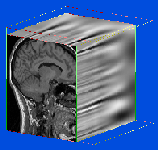
|
Scale Space and Medical Imaging
Prof. Bart M. Ter Haar Romeny
Image Sciences Institute,
University Hospital Utrecht, <--E01.334, -->
The Netherlands.
Course Schedule :
The course will be held at IMPA.
Period 30,31 of July and 3-5 of August.
One two-hour lecture each day at 10 am.
| Date | Room | Period |
|
30 and 31/July | 232 | 10:00 AS 12:00
|
03/August | 228 | 10:00 AS 12:00
|
04/August | 224 | 10:00 AS 12:00
|
05/August | 228 | 10:00 AS 12:00
|
|
The course will review linear scale space
and differential geometry, and give
applications in the area of medical imaging.
The course has a graduate level.
Abstract :
The course focuses on multiscale image analysis, its relation to human vision,
and the differential structure of images in a modern,
physics based approach.
Image analysis is the extraction of useful information from images. It has
become clear that a multiresolution approach is
indispensable. The physical reason is the fact that we deal with an observed
signal, where the aperture size of the measurement
device can be varied over some range, the scale-range. It turns out that the
human visual system also widely exploits a diversity of
multiscale filters in its processing layers.
In this course a modern mathematical (and physics based) approach to multiscale
image analysis is presented as a branch of
computer vision. We give an intuitive introduction to multiscale image
analysis, trying to keep the analogy with stages in the human
visual system as close as possible.
Among the topics covered are: the physical basis of regularization, the design
of differential invariant features in images to high
order, multiscale analysis of 2D and 3D shape, multiscale motion analysis from
image sequences, depth from stereo, orientation
analysis, and the use of contemporary, well-understood mathematical tools in
this field such as differential geometry and tensor analysis.
The majority of the examples discussed are from 2D, 3D and 4D (3D-time)
medical imaging. We devote some time to the efficient
numerical implementation of the different techniques. Experiments in
Mathematica 3.0 illustrate the theory and applications in practice.
Topics :
- Notion of scale in physics and mathematics
- Physics of observation, apertures
- Axiomatic derivation of some aperture kernels
- Differentiation, ill-/well-posedness and scale
- History of scale-space theory development
- Images as regular distributions
- The human visual pathway, receptive field (RF) structure
- Retinal distribution of RF's, feedback in the visual system
- Gaussian derivatives and the diffusion equation
- Some differential geometry on images in 2D, 3D, 2D-time
- Geometric Invariants
- Applications in medical imaging
- Multiscale optic flow
- Mathematical morphology
- The slope transform
- Nonlinear, geometry-driven diffusion schemes
- Divergence forms
- Curve evolution
- Diffusion tensor diffusion
- Summary
Literature :
A set of readers with selected papers and copies of the sheets will be handed out during the course.
Reading suggestions:
- B. M. ter Haar Romeny, L. M. J. Florack, J. J. Koenderink, and M. A
. Viergever, eds., Scale-Space '97: Proc. First Internat. Conf. on Scale-Space Theory in Computer Vision, vol. 1252 of Lecture Notes in Computer Science. Berlin: Springer Verlag, 1997.
- B. M. ter Haar Romeny, ed., Geometry-Driven Diffusion in Computer Vision. Dordrecht: Kluwer Academic Publishers, 1994.
- L. M. J. Florack, Image Structure. Dordrecht: Kluwer Academic Publishers, 1997.
- J. Sporring, M. Nielsen, P. Johansen, L.M.J. Florack (Eds.): Gaussian Scale-Space Theory. Dordrecht: Kluwer Academic Publishers, 1997.
- T. Lindeberg, Scale-Space Theory in Computer Vision. The Kluwer International Series in Engineering and Computer Science, Dordrecht, the Netherlands: Kluwer Academic Publishers, 1994.
- D. H. Hubel, Eye, Brain and Vision, vol. 22 of Scientific American Library. New York: Scientific American Press, 1988.

Example of an application of scale-space theory to medical imaging: 3D volume
visualization of a 7 week old human phoetus in the belly. Left: original data. Right:
3D nonlinear diffusion technique to reduce the noise while preserving edges. The
implementation in 3D uses ultrafast numerical methods. Technique: Joachim Weickert,
PhD, Utrecht University, 1997. Image acquisition: Kretz Combison 500, 2563
cubic dataset, interpolated from the original cone-beam echo acquisition.
Main Page | E-mail

